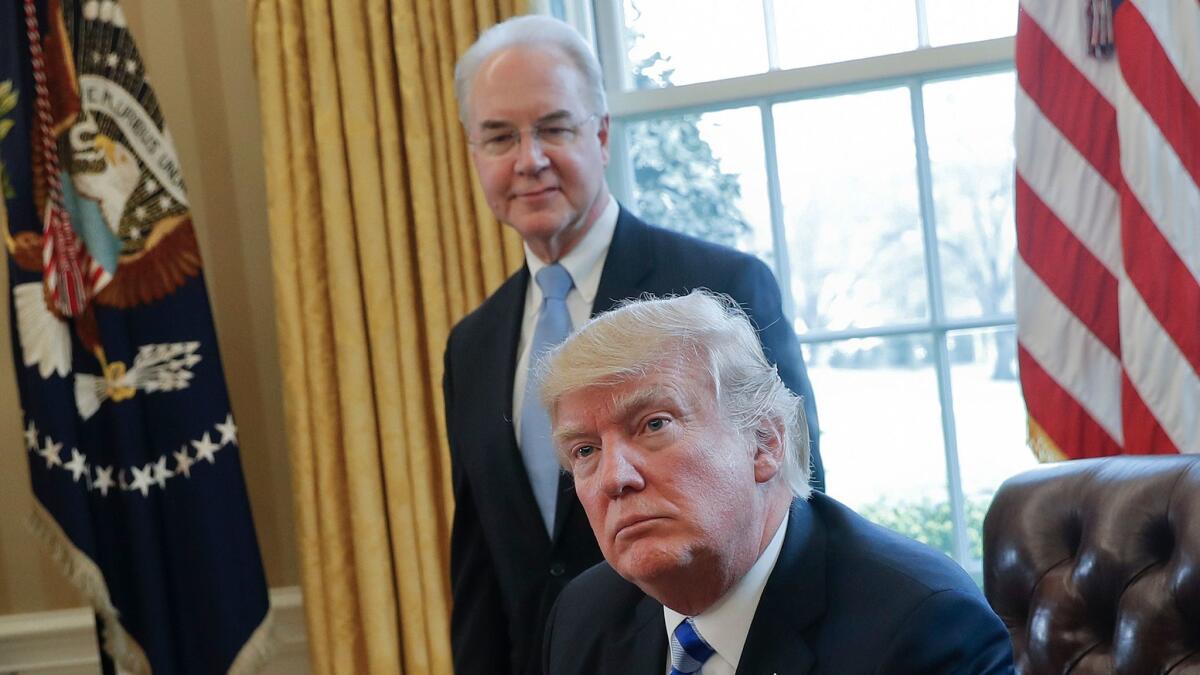Column: Trump’s team issues a stunningly dishonest study of Obamacare rate increases

The Department of Health and Human Services seemed mightily pleased with a statistic it issued Tuesday. The agency’s figures showed that premiums on the Affordable Care Act exchanges “doubled” from 2013 through this year.
This might not sound like good news for the people buying their coverage on those exchanges, but to HHS it was vindication. “This report is a sobering reminder of why reforming our healthcare system remains a top priority of the Trump administration,” agency spokesperson Alleigh Marré said.
Actually, it’s a sobering reminder of something completely different: the Trump administration’s stunning dishonesty about the ACA. That’s shown by the HHS statistic in two ways. First, the agency cherry-picked its time frame to make the premium increases under the ACA look much worse than they are. Second, the agency ignored the effect of Obamacare’s subsidies, which for many buyers has reduced the premium increases to zero.
Decisions are based on an applicant’s medical history, [and] the overall risk the applicant poses.
— Pre-ACA Blue Shield of California rejection guidelines
When Marré states that the data show that Americans are “paying nearly $3,000 more for health insurance per year,” that’s deceptive. The HHS report acknowledges that it’s using pre-subsidy prices, but only in a footnote to one chart in the report, in very small print. In other words, it’s deliberately hiding the truth.
Let’s take a closer look at the report, which is based on premiums in the 39 states using the federal government’s healthcare.gov website to enroll residents in ACA plans.
We’ll start with the time frame. HHS artfully compares 2017 premiums with 2013 premiums. But that’s not even comparing apples with oranges—it’s more like comparing apples with gruel. The 2013 market was pre-ACA, the year before the law’s mandates for benefits and protection for pre-existing conditions kicked in.
These were very different markets. In 2013, insurers could reject individual insurance applicants for even trivial glitches in their medical histories, impose steep surcharges on those with pre-existing conditions, or issue policies that excluded those conditions from coverage. Hundreds of conditions made it onto insurers’ rejection or surcharge lists, as this typical guide from Blue Shield of California shows—it runs to 25 pages. Coverage “decisions are based on an applicant’s medical history, [and] the overall risk the applicant poses,” the guide states.
That’s not even to mention conditions that almost no policies covered, such as maternity. Prior to the ACA—that is, in 2013—only 12% of policies in the individual market covered pregnancy and childbirth, surely among the most common medical conditions of women aged 18 to 45. As of 2014, maternity benefits were required of every individual policy by law.
In other words, the 2013 market was profoundly cherry-picked. Premiums were lower because insurers chose the youngest and healthiest customers they could find. In some states as many as one-third of all applicants were rejected, according to the Kaiser Family Foundation. And that’s almost certainly an underestimate, because many people with medical conditions didn’t bother to apply because they knew they’d be rejected.
The 2013 market also was rife with policies that ACA analyst Charles Gaba rightly labels “effectively garbage”—health plans that were little more than discount cards with limited applicability or plans with so many exclusions they offered buyers virtually no protection.
Starting in 2014, those stratagems were outlawed on the individual market. Insurers in any given region had to accept almost all applicants at the same premium. (They could surcharge smokers and charge older customers slightly more than younger.) Of course average premiums would rise, since insurers no longer could exclude risks. But for millions of Americans, health coverage was obtainable for the first time.
Not only that, policies in 2014 and beyond were much more useful than their predecessors. They could no longer include annual or lifetime benefit caps, and they had to cover maternity and nine other categories of benefits—“significantly richer coverage,” in the view of Loren Adler and Paul Ginsburg of the Brookings Institution. Some buyers, notably younger people and those with no adverse medical history, had to pay more on average, but for many more the change was a boon. “There’s simply no reasonable way to compare the premiums of the average individual market policies before the Affordable Care Act regulations kicked in to those sold since then,” Gaba observes.
The agency’s report acknowledges this too, but very quietly, noting that its analysis “does not account for the fact that the overall populations enrolling in the individual market in 2017 are different from those enrolling in 2013”—among other things, they’re older and less healthy.
The HHS’s own figures show that the bulk of the premium increases took place in the changeover from 2013 to 2014, when the entire market was revolutionized. For 2014, average premiums jumped about 24.5%, according to HHS figures. Recalculating the premium change under Obamacare alone—that is, from 2014 to 2017—one finds that average premiums rose a total of 39.5%. That’s comparing apples to apples, and it gives the lie to the Trump administration claim that Obamacare premiums doubled.
During that time frame, in fact, individual market premiums rose at roughly the same rate as they did during some periods in the pre-ACA era. In 2008-2010, for example, individual market premiums rose at a compounded rate of 36% (following annual increases of 9.9%, 10.8%, and 11.7%).
That brings us to the second deception in the administration’s report—the subsidy effect. An average of 85% of customers in the 39 healthcare.gov states are eligible for subsidies, which shelter them from the premium increases, reduce the effective increases to zero, or in some cases even yield lower rates. That’s because the subsidies are designed to rise in tandem with premiums.
Sometimes the subsidies even outpace premiums, especially if buyers shop around each year to find cheaper plans. In Arizona, for instance—a state whose eye-popping 116% premium increase for 2017 is regularly hauled out by Obamacare critics as a marker of the law’s failure—the subsidy increased 428% for low-income buyers in their 20s and 270% for families of four.
HHS acknowledges in a footnote to a chart in its report that the data “do not take into account premium tax credits.” One might ask, Why not? since the subsidies are an inextricable part of Obamacare.
The reason, plainly, is that including the subsidies would destroy the administration’s argument for repealing the law.
It’s proper to note that treating the revolutionary change from 2013 to 2014 as an apples-to-apples comparison was a favorite stunt of Obamacare detractors from the inception of the exchange market. The HHS report even links to some of their work from 2014, even though the methodology has been thoroughly debunked.
Nor is this the only example of the Trump administration’s cherry-picking. Kevin Drum of Mother Jones caught them at it just this week in their budget document, in which they attacked the Obama administration’s record on investment growth by incorporating the deep recession that began in 2008, before Obama took office.
All that underscores how little the figures coming out of this White House can be trusted. The only question is whether they’re being shameless, showing incompetence, or lying. We’ll leave that for you to judge.
Keep up to date with Michael Hiltzik. Follow @hiltzikm on Twitter, see his Facebook page, or email [email protected].
Return to Michael Hiltzik’s blog.
More to Read
Inside the business of entertainment
The Wide Shot brings you news, analysis and insights on everything from streaming wars to production — and what it all means for the future.
You may occasionally receive promotional content from the Los Angeles Times.











